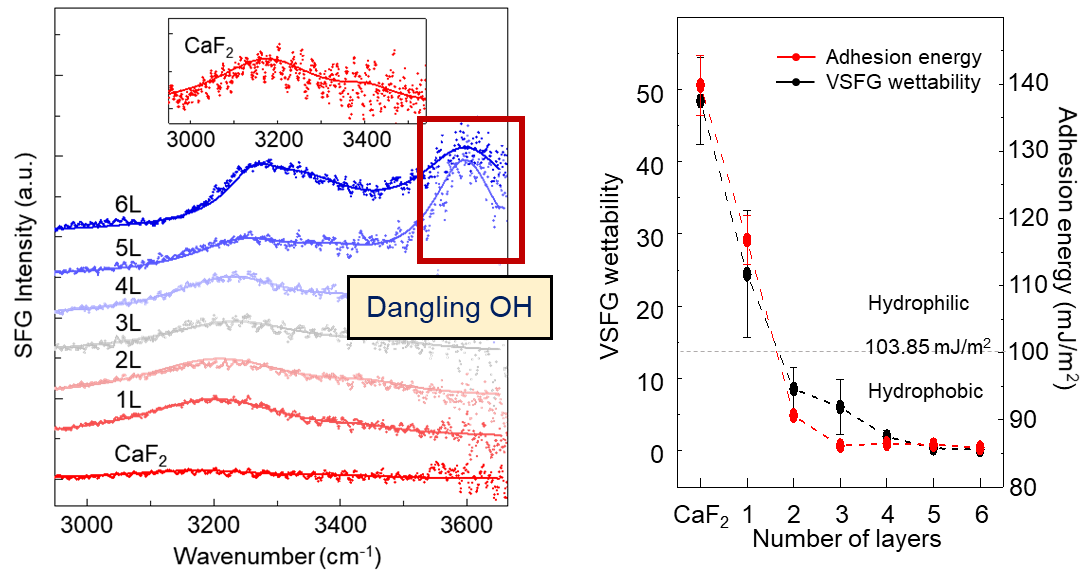Reviewed by Alex SmithApr 27 2022
The capacity of a liquid to sustain contact with a solid surface is called wettability, and it is proportional to hydrophilicity and inversely proportional to hydrophobicity. It is one of the most significant qualities of a solid.
 Figure 1. VSFG spectra of interfacial water at graphene/water interface and comparison of VSFG wettability and adhesion energy (left) VSFG spectra of interfacial water show that a dangling OH peak (3600 cm-1) appears when the graphene is more than 4 layers thick. (right) The calculated VSFG wettability is plotted against adhesion energy from macroscopic observation. Both values coincide closely, which indicates increasing hydrophobicity as the number of graphene layers increases. Image Credit: Institute for Basic Science.
Figure 1. VSFG spectra of interfacial water at graphene/water interface and comparison of VSFG wettability and adhesion energy (left) VSFG spectra of interfacial water show that a dangling OH peak (3600 cm-1) appears when the graphene is more than 4 layers thick. (right) The calculated VSFG wettability is plotted against adhesion energy from macroscopic observation. Both values coincide closely, which indicates increasing hydrophobicity as the number of graphene layers increases. Image Credit: Institute for Basic Science.
It is important to understand the wettability of various substrates for a number of industrial applications, including coating agents, desalination and water electrolytes.
Up until now, the majority of substrate wettability studies were done at the macroscopic level. The water contact angle (WCA), which is the angle a water droplet makes with regard to the substrate’s surface, is often used to estimate wettability on a macroscopic level.
However, measuring what happens at the molecular level at the interface between a substrate and water is still quite challenging.
Microscopic measurement techniques — like Raman spectroscopy or reflection-based infrared spectroscopy — that are used currently are not able to selectively observe the interfacial water molecules.
The interfacial water molecules’ signal is obscured by the water molecules’ signal in the bulk liquid, as the number of water molecules present in the entire bulk of the liquid is much more than the molecules that are coming into contact with the surface.
A research team from the Center for Molecular Spectroscopy and Dynamics (CMSD) within the Institute for Basic Science (IBS) in Seoul, South Korea, and Korea University discovered that vibrational sum-frequency generation spectroscopy (VSFG) can be utilized to measure the wettability of 2D-materials.
Using VSFG spectroscopy, the team succeeded in determining the vibrational mode of water molecules in graphene–water interactions.
VSFG is a beneficial method for linking macroscopic measurement findings to molecular-level features. It is a surface-selective instrument for studying interfacial molecules that use its own surface selection rule and has a high surface resolution with just a few molecular layers.
The scientists discovered graphene’s unique capacity to transfer the wettability of the substrate onto its surface, a property known as “wetting transparency.” They discovered that as the number of graphene layers grew, the wetting transparency declined, eventually vanishing when the graphene was more than four layers thick.
This is the first observation that showed that the graphene surface becomes hydrophobic over a specific number of layers at the molecular level.
The researchers also created a new concept called VSFG wettability, calculated as the proportion of water molecules that make strong hydrogen bonds to water molecules that form weak or no hydrogen bonds.
The wettability of the VSFG was closely associated with the adhesion energy, derived from the observed macroscopic WCA measurements. This demonstrates that the VSFG is an effective method for measuring the wettability of a material’s surface.
The researchers used VSFG wettability to evaluate the wettability of graphene in real-time when an electric field was applied to it to generate graphene oxide. Conventional WCA tests make it hard to detect wettability in real-time.
This suggests that VSFG could be a significant method for detecting water adhesion energy on any spatially constrained surface, where water contact angle measurement is impossible. VSFG spectroscopy, in addition to graphene, is expected to give information on the wettability of other low-dimensional materials.
This study confirmed that VSFG spectroscopy could be used as a versatile tool for measuring the wettability. We demonstrate the potential to measure the wettability of previously unobservable complex systems through VSFG spectroscopy.
Eunchan Kim, Study First Author, Institute for Basic Science
With VSFG spectroscopy, we are studying the microscopic properties of graphene as well as other two-dimensional functional materials such as graphene oxide and hexagonal boron nitride. Through this, it will be possible to solve various problems that hinder the commercialization of two-dimensional functional materials.
Prof. CHO Minhaeng, Director, Center for Molecular Spectroscopy and Dynamics
Journal Reference:
Kim. D. et al. (2022) Wettability of graphene and interfacial water structure. Chem. doi.org/10.1016/j.chempr.2021.03.006.